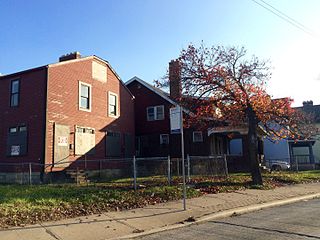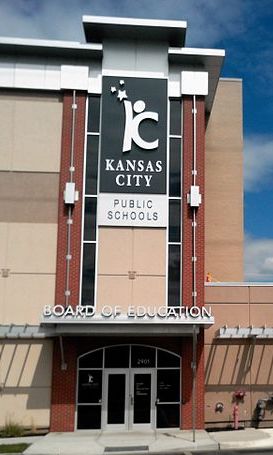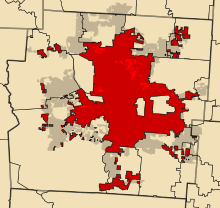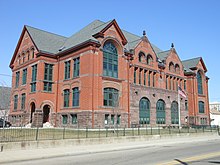
San Francisco Unified School District (SFUSD), established in 1851, is the only public school district within the City and County of San Francisco, and the first in the state of California. Under the management of the San Francisco Board of Education, the district serves approximately 49,500 students across 121 schools.
The Pasadena Unified School District (PUSD) was founded in 1874 and is a unified school district for Pasadena, Sierra Madre, and Altadena, in the U.S. state of California.

Atlanta Public Schools (APS) is a school district based in Atlanta, Georgia, United States. It is run by the Atlanta Board of Education with Interim Superintendent Dr. Danielle S. Battle. The system has an active enrollment of 54,956 students, attending a total of 103 school sites: 50 elementary schools, 15 middle schools, 21 high schools, four single-gender academies and 13 charter schools. The school system also supports two alternative schools for middle and/or high school students, two community schools, and an adult learning center.
The University District, is a 2.8-square-mile (7.3 km2) area located 2 miles (3.2 km) north of Downtown Columbus, Ohio that is home to the main campus of Ohio State University, the Battelle Institute, and Wexner Medical Center. It is generally accepted as the area bounded to the north by Clintonville at Glen Echo Ravine; to the south by the Short North at 5th Avenue; to the west by the Olentangy River and to east by the Conrail railroad tracks. Points of interest include, but are not limited to, the Ohio Stadium and Old North Columbus. The district is Columbus' most densely populated area and contains more than 650 businesses, human service agencies, churches, and schools. University District businesses include boutiques, mixed retail, several tattoo studios, the Gateway Film Center, and a diverse range of restaurants and bars.

Columbus Alternative High School is a public high school in the Columbus City Schools district located in the area known as North Linden, in Columbus, Ohio. The school is a magnet school for college-bound students in Columbus, with both AP and IB programs.
The South-Western City School District (SWCSD) is Ohio's sixth largest public school district located southwest of the city of Columbus. The district serves nearly 20,000 students throughout the southwest quadrant of Franklin County, including the cities of Galloway, Georgesville, Grove City, and Urbancrest. The district also serves all of Franklin, Jackson, Pleasant, and Prairie townships and a portion of Columbus.

Linden is a neighborhood in northeastern Columbus, Ohio. It was established in 1908 as Linden Heights Village, and was annexed into Columbus in 1921. The neighborhood saw high levels of development in the 1920s. By the 1960s, suburban development, city income taxation and racial factors caused families, especially white residents, to leave the neighborhood. Since this time, Linden has struggled with poverty, crime, vacancies, and health and societal problems.

Minneapolis Public Schools (MPS) or Special School District Number 1 is a public school district serving students in pre-kindergarten through twelfth grade from Minneapolis, Minnesota. Minneapolis Public Schools enrolls 36,370 students in public primary and secondary schools. The district administers about one hundred public schools including forty-five elementary schools, seven middle schools, seven high schools, eight special education schools, eight alternative schools, nineteen contract alternative schools, and five charter schools. With authority granted by the state legislature, the school board makes policy, selects the superintendent, and oversees the district's budget, curriculum, personnel, and facilities. Students speak ninety different languages at home and most school communications are printed in English, Hmong, Spanish, and Somali.
Columbus, the state capital and Ohio's largest city, has numerous neighborhoods within its city limits. Neighborhood names and boundaries are not officially defined. They may vary or change from time to time due to demographic and economic variables.
Mansfield City School District is a public school district serving students in the city of Mansfield, and northwestern parts of Madison Township in Richland County, Ohio, United States. The school district enrolls 4,591 students as of the 2012-2013 academic year.

Graham Elementary and Middle School is a public K-8 charter school in Columbus, Ohio. It was originally the Indianola Junior High School, the first junior high school in the United States. The building was owned by the Columbus City Schools, though it became operated by the Graham Family of Schools, and was sold to the organization in 2017. 2009 was the middle school's centennial year. Shortly thereafter, the school board closed that building for the 2010 school year and merged the school with the former Indianola Alternative School.
Springfield City School District is the public school district that serves the city of Springfield, Ohio. It operates 14 schools: ten elementary, three middle, and one high. The district is led by superintendent Robert Hill.
The Sunflower County Consolidated School District (SCCSD), formerly the Sunflower County School District (SCSD), is a public school district with its headquarters in Indianola, Mississippi in the Mississippi Delta. The district serves all of Sunflower County.

Old North Columbus is a neighborhood located just north of the Ohio State University in Columbus, Ohio. It was founded in 1847 where, at the time, it was a stand-alone city out of the confines of Columbus until it was incorporated into the City of Columbus in 1871. In its early years the city was a popular stagecoach stop with people traveling from Worthington to Columbus. Today Old North Columbus is popular for its local music and its unique "untouched architecture" which is reminiscent of its old roots.

Kansas City 33 School District, operating as Kansas City Public Schools or KCPS, is a school district headquartered at 2901 Troost Avenue in Kansas City, Missouri, United States.

Bridgeport Public Schools is a school district headquartered in Bridgeport, Connecticut, United States.
Champaign Community Unit School District No. 4 is a unit school district with over 10,000 students and 19 campuses covering Champaign and the villages of Bondville and Savoy in Champaign County, Illinois, United States. It was formed in 1948 from thirteen school districts.

Weinland Park is a neighborhood north of downtown Columbus, Ohio and encompassed by the boundaries of the University District. A development boom in the 1930s and 1940s resulting from new streetcar lines and the blossoming of factories brought working and middle-class families to the neighborhood. Current housing stock consists primarily of single family residential buildings that have been converted to rentals or multifamily housing. Row-homes and apartment buildings are also ubiquitous in the neighborhood. Renters currently outnumber owners. Commercial and entertainment facilities are concentrated on the North High Street corridor, but also pocket the inner part of the neighborhood as well. Weinland Park saw the sapping of its population and wealth with the rise of newer suburbs ringing the outer reaches of the city and the collapse of local industry and streetcar lines. The neighborhood has been plagued with crime and drug problems for decades but has recently seen a flood of new investment that has brought growth and revitalization to this long struggling neighborhood. Investment into the community includes the South Campus Gateway providing retail and residential finished in 2005, and a new food district and employment center.

Indianola Junior High School is a historic school building located on 19th Avenue in Columbus, Ohio. The building opened in 1929 after the school moved out of its previous location on 16th Avenue. It was added to the National Register of Historic Places in 1980.
































